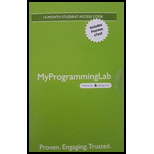
Concept explainers
19.9 (Package Inheritance Hierarchy) Package-delivery services, such as FedEx®, DHL® and UPS®, offer a number of different shipping options, each with specific costs associated. Create an inheritance hierarchy to represent various types of packages. Use class Package as the base class of the hierarchy, then include classes TwoDayPackage and OvernightPackage that derive from Package. Base class Package should include data members representing the name, address, city, state and ZIP code for both the sender and the recipient of the package, in addition to data members that store the weight (in ounces) and cost per ounce to ship the package. Package ‘5 constructor should initialize these data members. Ensure that the weight and cost per ounce contain positive values. Package should provide a public member function calculatecost that returns a double indicating the cost associated with shipping the package. Package ‘5 calculatecost function should determine the cost by multiplying the weight by the cost per ounce. Derived class TwoDayPackage should inherit the functionality of base class Package, but also include a data member that represents a flat fee that the shipping company charges for two-day-delivery service. TwoDayPackage’s constructor should receive a value to initialize this data member. TwoDayPackage should redefine member function calculatecost 50 that it computes the shipping cost by adding the flat fee to the weight-based cost calculated by base class Package ‘S calculateCost function. Class OvernightPackage should inherit directly from class Package and contain an additional data member representing an additional fee per ounce charged for overnight-delivery service. OvernightPackage should redefine member function calculatecost so that it adds the additional fee per ounce to the standard cost per ounce before calculating the shipping cost. Write a test program that creates objects of each type of Package and tests member function calculatecost.
Want to see the full answer?
Check out a sample textbook solution
Chapter 19 Solutions
MYPROGRAMMINGLAB WITH PEARSON ETEXT
Additional Engineering Textbook Solutions
Concepts Of Programming Languages
Web Development and Design Foundations with HTML5 (8th Edition)
Java: An Introduction to Problem Solving and Programming (8th Edition)
Starting Out with Programming Logic and Design (5th Edition) (What's New in Computer Science)
Elementary Surveying: An Introduction To Geomatics (15th Edition)
Computer Science: An Overview (13th Edition) (What's New in Computer Science)
 C++ Programming: From Problem Analysis to Program...Computer ScienceISBN:9781337102087Author:D. S. MalikPublisher:Cengage Learning
C++ Programming: From Problem Analysis to Program...Computer ScienceISBN:9781337102087Author:D. S. MalikPublisher:Cengage Learning C++ for Engineers and ScientistsComputer ScienceISBN:9781133187844Author:Bronson, Gary J.Publisher:Course Technology Ptr
C++ for Engineers and ScientistsComputer ScienceISBN:9781133187844Author:Bronson, Gary J.Publisher:Course Technology Ptr Microsoft Visual C#Computer ScienceISBN:9781337102100Author:Joyce, Farrell.Publisher:Cengage Learning,
Microsoft Visual C#Computer ScienceISBN:9781337102100Author:Joyce, Farrell.Publisher:Cengage Learning, Systems ArchitectureComputer ScienceISBN:9781305080195Author:Stephen D. BurdPublisher:Cengage LearningProgramming Logic & Design ComprehensiveComputer ScienceISBN:9781337669405Author:FARRELLPublisher:Cengage
Systems ArchitectureComputer ScienceISBN:9781305080195Author:Stephen D. BurdPublisher:Cengage LearningProgramming Logic & Design ComprehensiveComputer ScienceISBN:9781337669405Author:FARRELLPublisher:Cengage EBK JAVA PROGRAMMINGComputer ScienceISBN:9781337671385Author:FARRELLPublisher:CENGAGE LEARNING - CONSIGNMENT
EBK JAVA PROGRAMMINGComputer ScienceISBN:9781337671385Author:FARRELLPublisher:CENGAGE LEARNING - CONSIGNMENT





